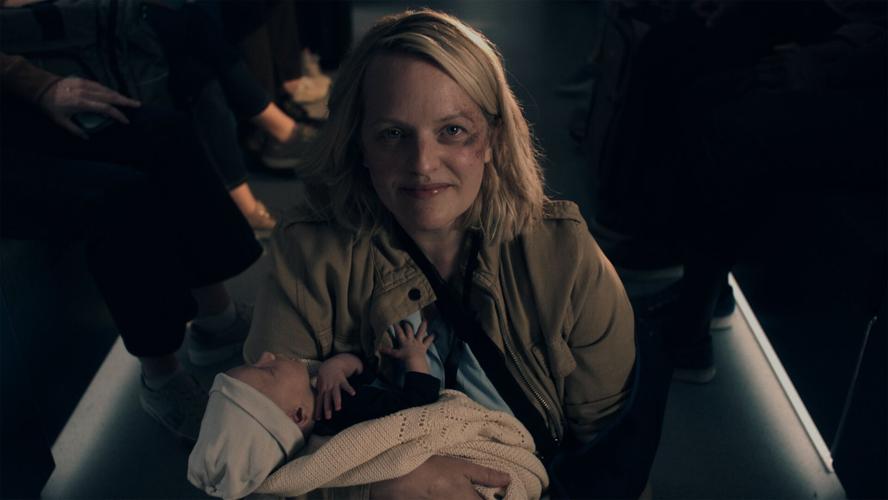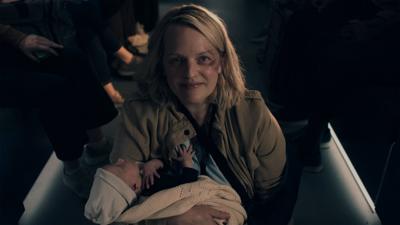When actor D’Arcy Carden first walked into the huge wardrobe room inside Toronto’s Cinespace Studios where costumes for “The Handmaid’s Tale” were stored, she was overwhelmed.Ìý
It was “just rows and rows of the red cloaks and the red dresses and the white wings. And it kind of took my breath away. It’s such a symbol. I mean, it’s so much more than just a costume, you know?” she told a group of reporters gathered at the Etobicoke studio in mid-December.Ìý
Indeed, the blood-red garb worn by the “handmaids” onÌýthe TV show — women who have been coerced into sexual slavery in a near-future American theocracy — has become a visual shorthand: not just for fans of the series, which has filmed all six of its seasons in and around Toronto, but for people around the world fighting for women’s rights.
Carden, an American,Ìý is a newcomer to the program, playing a character who can’t be revealed yet.Ìý
On this particular day in the studio, we were back in the religious republic of Gilead, which in the show controls much of the United States. Reporters watched a scene being shot inside the home of Commander Lawrence (Bradley Whitford), one of the men running Gilead’s totalitarian government. A group of commanders’ wives — dressed in their distinctive teal ensembles — were having tea and sometimes barbed conversation.
While spoilers are forbidden for this final season, which begins Tuesday on Crave and Prime Video, it’s fair to say there are callbacks — visually, thematically and characterwise — to the very first season, which debuted in April 2017, winning eight Emmys that year, including outstanding drama series.

The red costumes of “The Handmaid’s Tale,” seen in an earlier season, have become visual shorthand both for the show and for women’s rights protests around the world.
George Kraychyk/TNS file photo“I think it’s an emotional, compelling and surprising journey,” co-showrunner Eric TuchmanÌýsaid of the 10 episodes that will conclude the show.Ìý
“It’s really a now or never, do or die vibe this season in the fight against Gilead,” he added. “There’s a sense that time is running out unless our characters take real action, and it’s action the audience has been waiting for for five seasons.”
Viewers who have stuck with “The Handmaid’s Tale” have done so despite violent and disturbing content, including depictions of the ritual rape of handmaids, and punishments for women who defied Gilead that included genital mutilation and hanging. And then there was the psychic violence of having their children taken away, both the ones they had pre-Gilead and the ones they bore as handmaids.
In turn, the female-led resistance has been violent, most memorably in Season 4 when a group of former handmaids literally tore a commander to death in No Man’s Land, the disputed territory on the border of Canada and Gilead.

Yahlin Chang and Eric Tuchman are co-showrunners of “The Handmaid’s Tale.”Ìý
Kevin Winter/Getty ImagesIt’s not a spoiler to say that more violence is on tap this season with rebellion brewing, as the series trailer makes clear.
“I’m very aware that this show can be challenging to watch,” said Tuchman. “But it’s not about living in the trauma that the characters have experienced; it’s about their strength, their courage, their resilience. And it’s about hope.”
Tuchman was asked if there was pressure to stick the show’s landing, given the vociferous reactions of fans to other series finales that didn’t live up to their expectations.
Sure, he responded, but it wasn’t allowed to bleed into the writers’ room.
“It’s always about where is June (the handmaid of the title)? What would be the next step in her journey that would challenge her, that would put her in dramatic, intense situations where she can be tested as a character, where her relationships can be tested and explored? So we stick to that. We try not to think too much beyond it,” he said.
‘Juliet andÌýJuliet’
Viewers have followed June — played by Emmy winner Elisabeth Moss — from handmaid to rebel to refugee, as she fled Gilead for Canada.
Where she is as Season 6 begins is where the showÌýleft her at the end of Season 5: on a train leaving Canada.
Whereas pc28¹ÙÍøwas initially a haven for June and other Gilead escapees, anti-refugee sentiment has made it less welcoming. June was even run down in front of her home by a Gilead sympathizer, escaping death only because her husband, Luke (O-T Fagbenle), pulled the driver out of his pickup truck and beat him — so severely that he died in hospital, which is why Luke, June and her baby, Nichole, were trying to flee in the Season 5 finale.

Elisabeth Moss as June and Yvonne Strahovski as Serena in the final season of “The Handmaid’s Tale.” There’s “an incredible amount of evolving in their relationship,” Moss says.
Steve Wilkie/DisneyBut with Luke arrested at the station for killing June’s attacker, only she and Nichole got on the train. In the final scene, she encountered Serena (Yvonne Strahovski), bolting fromÌýpc28¹ÙÍøwith her own baby — the woman who, as a commander’s wife in Gilead, participated in June’s rape by Serena’s husband; the same husband June helped beat to death, later sending his severed ring finger to Serena.
Complicated doesn’t even begin to describe their relationship, which is arguably the most important one in the show.
“Lizzie and I have a joke that we’re like Juliet and Juliet, like these lovers in a very dysfunctional relationship, and we always find ourselves back with each other and have these amazing, intense moments. And then it crashes and burns,” said Australian actor Strahovski in an interview at the studio, referring to Moss by the name everyone on set calls her.
“I feel like this is probably the most raw, most real, most honest version of their relationship that we’re going to see. And I think there will be times this season where we almost feel like they have arrived at a friendship.”
Yet June can’t accept “what Serena represents, and what she bought into and what she turned a blind eye to in Gilead’s evolution,” Strahovski added. “She says to Serena, ‘I want to forgive you, but I can’t.’”
Ìý
June, Moss said during a separate video interview, “knows exactly who Serena is and she really has her number in a way that no one else does.” But “throughout the course of the season, Serena does disappoint her again, as Serena always does.”
Still, “there’s an incredible amount of evolving in their relationship this year,” Moss added. “I love where they end up. I think where they end in the final episode is exactly where (they) should be.”
‘A superhero level’
If June is the most important figure in “The Handmaid’s Tale,” Moss seems to serve the same function in the making of the show. She is not only its star but an executive producer and director.

Elisabeth Moss with director of photography Nicola Daley working on the final season of “The Handmaid’s Tale.”Ìý
Steve Wilkie/Disney“She’s a phenomenal actor, but she is (also) a fantastic leader,” said Amanda Brugel, the only Canadian in the main cast, of Moss. “She operates at a sort of superhero level. And so, just to keep up with her, because we love her, are truly inspired by her and want to raise the bar with her, we’re all so passionate about the show.”
Tuchman said that Moss, who directed the first two and the last two episodes of this season, has “become this accomplished, magnificent auteur who knows the show better than anybody. She’s gonna bring us home.”
It was clear, though, in all the interviews at the studio that the love for Lizzie was part of a general closeness among the people who have been making this series in pc28¹ÙÍøsince 2016 — excepting interruptions for the COVID pandemic, and the writers’ and actors’ strikes.

Ever Carradine as Naomi with Bradley Whitford as Commander Lawrence in “The Handmaid’s Tale.”Ìý
Steve Wilkie/Disney“I mean, people have been married since we began this show. Many children have been born,” said Ever Carradine, who plays commander’s wife Naomi.

Actor D’Arcy Carden at the Season 6 premiere of “The Handmaid’s Tale” this week in Los Angeles.Ìý
Jordan Strauss/Invision/AP“This cast and crew is in love with each other. They are obsessed with each other,” said Carden.
Tuchman called the crew, most of whom are Canadian, “the greatest crew in television.”
“Everyone who works (on the show), from craft (services) all the way to the writers, to everyone who (acts) on the show, is spectacular at their jobs,” Brugel said.
“I’m gonna miss pc28¹ÙÍøas much as I’m gonna miss my cast,” added Carradine.
Before she joined “Handmaid’s Tale,” Carden assumed that, given the subject matter, days on set were hard for the actors. But she ran into Whitford on a plane and he told her, ”‘It is so fun. It is the warmest cast. We are laughing up until they call action. There are dance parties.’ And (it’s) exactly true. People are laughing and joking around and telling stories up until (they call) ‘places,’Ìýwhich makes it easier when the heavy stuff comes.”
‘A symbol of empowerment’
That heavy stuff, of course, originated in the 1985 novel “The Handmaid’s Tale” by Canadian author Margaret Atwood, which Tuchman called the show’s bible — although the series has expanded far beyond the source material. (Atwood remains a co-executive producer and is given access to all the scripts.)
Tuchman pointed out, as others have before him, that “everything in the book in regards to the oppression and mistreatment of women can be traced to something real in our history, not just in America, in the world.”Ìý
Nonetheless, there is a particular resonance to this final season debuting during the second Trump presidency, with women’s reproductive rights severely restricted in some states since the overturning of Roe v. Wade, the U.S. Supreme Court decision that gave American women the constitutional right to abortion in 1973.Ìý
“Until women are equal it will always be a mirror,” Carden said of the show. “It will always feel relevant. (People) will always be able to relate to it. How wonderful would it be if our kids and grandkids could not relate to this story?”
Still, Tuchman called it inspiring that the red handmaid’s costumes — which have been adopted around the world by protesters for women’s rightsÌý— have “become a symbol of empowerment, (of) defiance and standing up for yourself, and for what’s right and what you deserve as a woman.”Ìý
“Sometimes as an actor, you’re made to feel like your job isn’t important,” added Carradine. “It’s been very gratifying to be on something (where) I really feel proud of the impact that this show has had.”
Moss, who was editing the series finale the day of last week’s chat, was feeling proud, too.
“WeÌýwere shooting the final scene and I remember watching the final take with cinematographer Stuart Biddlecombe, and it brought tears to my eyes, because I looked at him and I said, ‘That’s how this show is supposed to end. That’s it.’
“I am beyond proud of it. I really am. There’s nothing I would want to do differently.”
The first three episodes of the final season of “The Handmaid’s Tale” debut April 8 on Prime Video and Crave, with subsequent episodes every Tuesday.Ìý





































To join the conversation set a first and last name in your user profile.
Sign in or register for free to join the Conversation